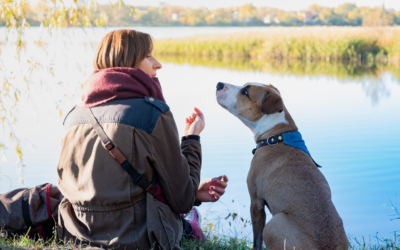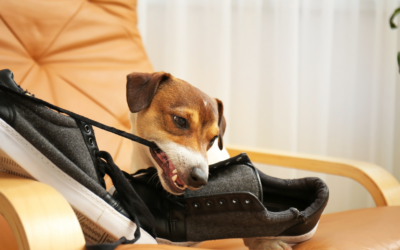Do you have a new baby on the way? Or have a puppy and wanting to get them used to different noises? Then this post is for you!
Why is noise exposure important?
Hearing is a very important sense to dogs, and can be responsible for stress, excitement, and many other emotions in your dog. Is there a sound associated with meal prep that makes your dog come running into the room all excited? Or does the sound of thunder or a vacuum make your dog tremble and hide?
Some dogs are much more affected by sounds than others, but all dogs (as long as they can hear) can learn to associate sounds with something positive or something negative.
Noise exposure as a part of socialization
Getting puppies used to various noises is something that dog trainers usually recommend for puppies. This is considered to be part of the socialization process. As in all socialization, you always want to make sure that this is a positive exposure. Ensure that your dog is not scared of the noise stimulus so you don't accidentally create fear in your dog.
You don’t want to initially expose puppies to loud, scary noises. Instead, use low to moderate noises and associate that with a treat or something else they like. Having the vacuum running in another room while they’re eating is one idea.
Ideally, when they’re young (ie under 3-4 months of age), you’d like to give them positive exposures to as many things as possible, including the different noises they may hear throughout their lives. The more varied and positive exposures they get, the less likely they’ll be worried about new things as they age.
Noise exposure when preparing your dog for baby
There are many things you can be doing to help your dog get prepared for baby, and exposure to baby noises is one that is very helpful. Some dogs find the sound of crying, fussing babies to be stressful. Alternatively, the opposite can happen and those noises can cause more excitement (something you definitely don’t want around a new baby!). A crying baby can also be very stressful for parents, and that can make the experience even more worrisome for your dog.
While you can’t fully role-play all the factors involved in a crying baby, you can get dogs used to the sound portion of the experience. You can play baby sounds before baby arrives, and pair is with something positive. This creates a good association with those sounds and they aren’t as stressful. Along with this, you can also teach your dog to do something when they hear a particular sound, such as going to a mat. We’re going to go into detail about how to do both of these below.
There are many, many YouTube videos and other sources online of babies cooing, crying, and other noises for these exercises.
Desensitization and counterconditioning to baby noises
Here are some steps for getting your dog ready:
- Choose a time of day when you have 5-10 minutes to spend with your dog and your dog is reasonably relaxed
- Get some high value treats and your source of baby noises ready (if you need information on finding high value treats – see this post!).
- Give your dog a treat or two and then put the sounds on VERY low and at a distance from your dog. You don’t want it to be right in your dogs’ face/ear.
- Don’t worry about obedience at all for this exercise, if your dog wants to sit or lie down, that’s fine. We’re focusing on preventing fear and excitement with baby noises here, not training.
- Give your dog treats, if they’re taking them gently and slowly, then continue to give treats every few seconds. If your dog is taking them very quickly or roughly, then you need to take a step back. Turn the volume down even more. The goal is to get to a point where your dog is nice and relaxed.
- Do this at least once a day for 3-5 minutes (if you can do more sessions a day that’s great!).
- VERY gradually increase the volume – this is a process that usually takes several weeks. You don’t ever want to scare your dog by increasing the volume too quickly, that will set you back even further.
- Continue giving treats during all of the sessions. You really want to be making the connection for your dog that baby noises = something good. This teaches them that they can remain relaxed and there’s no reason to get excited or anxious.
(Note – this process can be used for desensitizing to many other noises as well!)
Teaching your dog to do something when hearing baby noises
In addition to desensitizing your dog to baby noises, you can teach them to do an alternate behaviour instead. If you have a dog that is naturally a little more anxious, giving them a ‘job’ to do is often really helpful.
This one requires a bit of thinking through. What would you like to have your dog do if the baby is crying or fussing? Do you want them to go to a particular spot? Will it depend on where you are in your home? Make sure you think about this one first. An example is teaching your dog to go to a particular bed or mat. The bed can then be moved around your home if you need to.
Once you have spent time desensitizing your dog to the sound of baby noises, you can teach go to mat. If you are working on this activity, make sure that you also continue the desensitization exercises ON the mat as well. You want to keep reinforcing calm and relaxed behaviour when hearing baby noises.
If you’re expecting, or know someone who is, make sure you check out Wags & Giggles – the ultimate ‘prenatal' course to help prepare dogs for a new baby.
IMPORTANT NOTE
If you're experiencing behaviour problems in your dog, the best (but not only) time to work on them is before baby arrives. Taking the time to work on any issues, especially ones that could be a safety concern, is very important. If you aren't working with someone currently, virtual consultations with Dr. Janet Cutler can be booked here.



